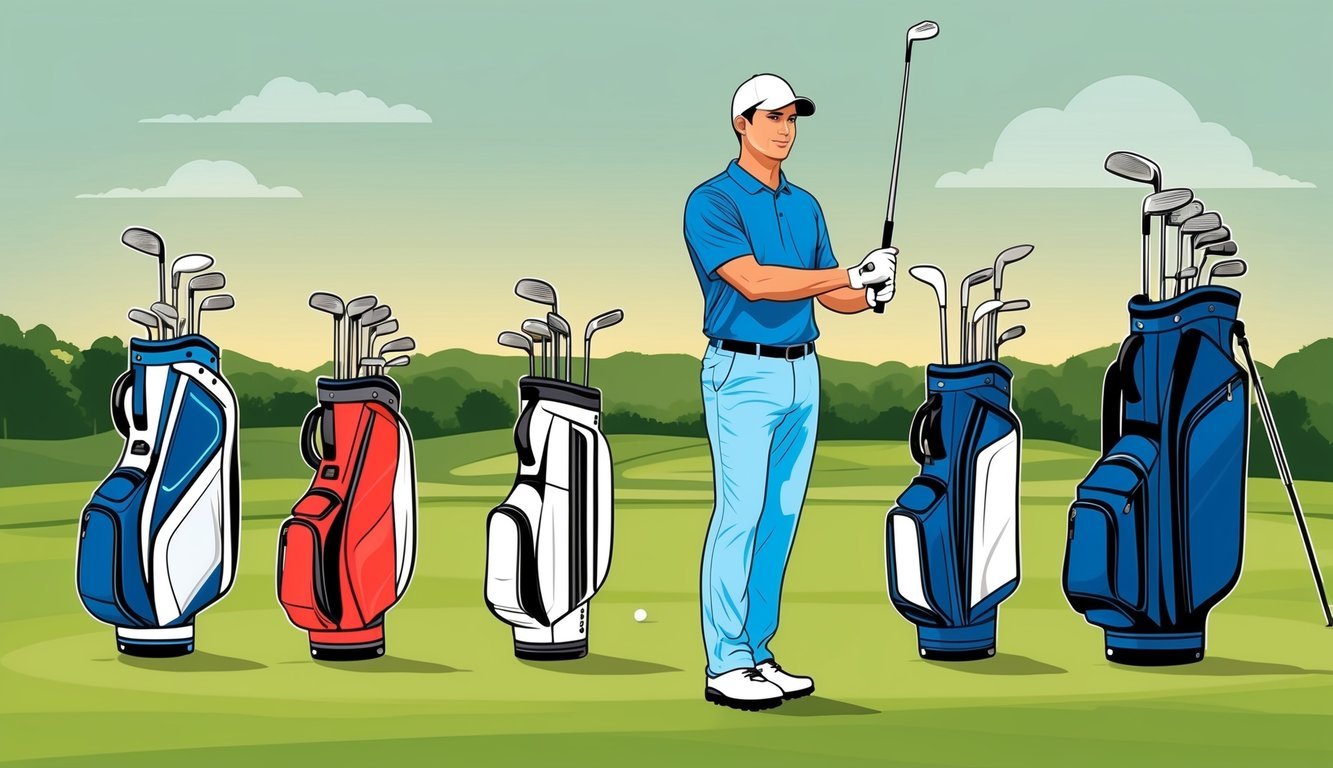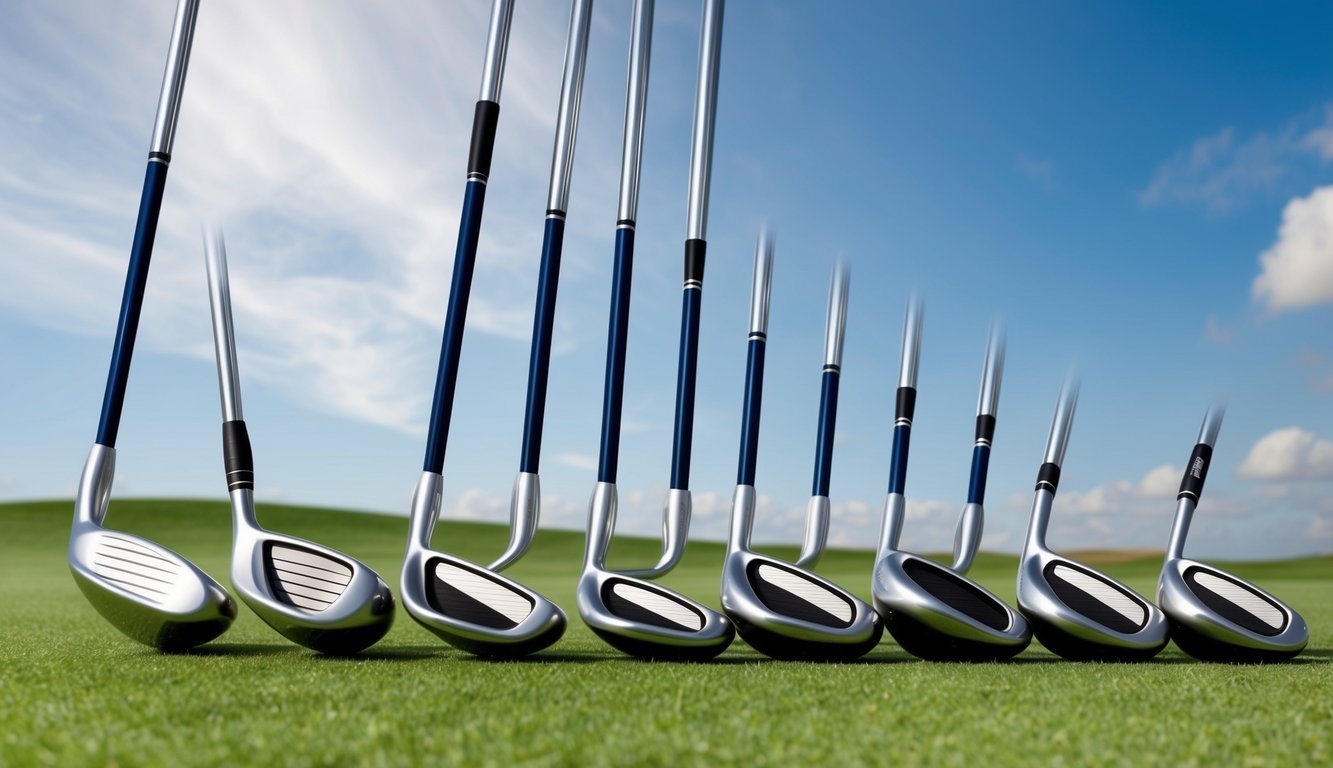Exploring the world of golf clubs reveals a fascinating aspect: loft.
This angle on the clubface is crucial in determining how the ball flies through the air.
Understanding the loft of each golf club can significantly improve how far and accurately you can hit the ball.
Whether you’re a beginner or a seasoned player, adjusting the loft to suit your game can lead to better control and precision.

Each type of golf club—from drivers to putters—has a specific loft that affects how the ball launches and spins.
The right combination can enhance accuracy and distance, leading to improved performance on the course.
You might be surprised at how tweaking a degree or two in loft changes your game play and club selection strategy.
Advances in club design technology now allow for more personalized adjustments, giving you more flexibility to tailor your equipment to your skill level.
Embracing these options can elevate your game, offering a competitive edge in both casual and competitive rounds.
Dive further into how this can change the way you approach each swing and every hole.
Key Takeaways
- Golf club loft affects ball flight and precision.
- Loft adjustment can improve control and distance.
- Technological advancements offer more loft customization.
Understanding Golf Club Lofts
Golf club lofts are key to understanding how far and how high your golf ball will go.
Different clubs have varying lofts that can influence your shot’s trajectory and distance.
Basic Concepts of Loft
The loft of a golf club is the angle between the clubface and the ground.
It affects the ball’s launch trajectory and spin.
A lower loft means the clubface is more upright, helping you hit longer shots, typically seen in driver lofts which range from 8 to 12 degrees.
A higher loft creates more spin and a steeper trajectory.
Wedges, for example, can have lofts upwards of 50 degrees, which allows for precise control on shorter shots.
This understanding helps you select the right club for each situation.
Loft Angles Across the Bag
Different clubs come with unique loft specifications. Iron lofts range from 18 degrees for a 2-iron to 48 degrees for a 9-iron, providing a balance between distance and control.
Fairway wood lofts and hybrid lofts offer options for shots off the tee or fairway, typically between 15 to 22 degrees.
Putters, having the least loft around 3 to 4 degrees, keep the ball low and at a rolling pace.
Understanding these variations helps you make better choices on the course.
For more details, check out a Golf Club Loft Chart.
Impact of Loft on Ball Flight
The loft of a golf club significantly affects how the ball travels through the air.
It influences both the distance and the flight path of the ball, as well as how much spin it experiences during its journey.
Distance and Trajectory
When you adjust the loft of your golf club, you’re essentially manipulating the launch angle at which the ball leaves the clubface.
A higher loft increases the height of the ball’s flight, allowing it to travel in a higher arc.
Long irons typically have lower lofts, between 18-24 degrees, promoting a lower, more penetrating trajectory.
In contrast, a lob wedge, with over 60 degrees of loft, launches the ball higher.
This helps you achieve maximum control over the distance and trajectory of your shots, especially for approaches to the green.
Spin and Flight Dynamics
The amount of spin generated by a golf club is directly related to its loft.
As the loft increases, so does the backspin on the ball, which influences its flight dynamics.
A higher backspin helps stabilize the ball’s flight.
Additionally, clubs with more loft produce higher spin rates and a more controlled, softer landing.
When adjusting your driver or iron lofts, noticing these changes in spin and flight dynamics can significantly impact your distance control and shot accuracy.
The Role of Loft in Golf Club Selection

Golf club lofts greatly influence your game by affecting shot distance and trajectory.
Different loft angles cater to specific needs, from driving long distances to precise short shots.
Choosing the Right Club for the Shot
Selecting a club with the appropriate loft is essential for optimizing your shots.
Loft angles determine the ball’s launch angle and spin, impacting both distance and accuracy.
For example, drivers typically have lower lofts, like 8 to 10.5 degrees, to maximize distance.
In contrast, wedges such as the sand wedge (around 54-58 degrees) and lob wedge (above 58 degrees) offer higher lofts for shorter, accurate shots.
Using a golf club loft chart helps visualize these differences.
Assessing the course conditions and personal skill level will guide your decision in club selection.
Beginner golfers might struggle with lower loft clubs, while experienced players can manipulate loft to their advantage.
Loft Customization and Fitting
Customizing lofts through club fitting enhances your game by tailoring to your swing and preferences.
Manufacturer standards might not suit everyone, so adjustments are key.
Professional fitting identifies the ideal loft for each club in your set, from driver lofts to wedges.
For many, this involves fine-tuning to find the right gaps between clubs, like the gap or pitching wedges, to ensure consistent coverage of all distances.
Consider your club fitting as a dynamic process, evolving with changes in your playing style or skill level.
A fitting expert can guide modifications, ensuring your clubs complement your strengths and compensate for weaknesses.
Loft Considerations for Different Skill Levels

Choosing the right golf club loft depends greatly on your skill level.
For beginners, higher lofts can improve ball flight and forgiveness, while advanced players often benefit from precise control with lower lofts.
Beginners and High Handicappers
When you’re just getting started or have a high handicap, clubs with higher lofts can be your best friends.
These clubs usually allow for easier elevation of the ball, which is important for building confidence and consistency on the course.
Game improvement irons from brands like TaylorMade, Callaway, and Cobra are often designed with higher lofts to provide more forgiveness.
If you’re struggling with lower swing speeds, a higher loft helps you achieve better launch angles.
This means the ball can stay in the air longer, giving you more distance without needing a perfect swing.
By using clubs fitted for your current skill, you can enjoy a more rewarding game and gradually work up to lower loft options as you improve.
Advanced Players and Professionals
For more experienced golfers, such as better players and tour professionals, clubs with lower lofts become more appealing.
These lofts allow for more control over the ball’s flight and spin rates, a necessity for playing on challenging courses.
Players like Bryson DeChambeau often utilize equipment with specific loft adjustments to suit their unique swing speeds and play styles.
Professional golfers often favor brands such as Mizuno for their game, thanks to their focus on precise loft configurations.
Lower lofts offer the ability to manipulate ball trajectory more effectively, providing the versatility needed for various shot-making scenarios on the course.
By carefully selecting clubs that complement your refined skills, you can maximize your performance.
Technological Advances and Club Design

Understanding the advancements in golf club technology can elevate your game.
Modern designs focus on adjustability and performance, combining engineering and materials innovation to enhance your experience.
Innovations in Loft Adjustments
Adjustable hosels are a game-changer, allowing you to tweak the loft for your preferred trajectory.
This feature is particularly useful in drivers and fairway woods, providing flexibility in how high or low the ball flies.
You might find it in some hybrid clubs as well, helping tailor the club to various course conditions.
A loft and lie machine is used during club fitting to fine-tune the angles.
Brands like Mizuno excel in this area, with models such as the Mizuno MP-20 known for precision adjustments.
These innovations give golfers the chance to optimize each shot, making the game more adaptable to individual styles.
Impact on Performance
Modern clubhead designs focus on larger sweet spots, which help you achieve better outcomes even on off-center hits.
This is especially notable in irons and putters, where precision is crucial.
Shaft flex and lie angle also play critical roles, affecting how the club behaves through the swing.
With innovations in materials and construction, you can expect a performance boost in drivers and woods, where distance and accuracy are key. 3 hybrids and other hybrid clubs often blend the best features of irons and woods, offering versatility on various lies.
By selecting the right combination of club model and specifications, you can significantly improve your performance on the course.
Strategic Use of Loft in Game Play

Understanding the loft of your golf clubs enhances your ability to adapt to varying conditions and manage your club choices.
This involves considering environmental factors as well as strategically utilizing the differences in loft angles.
Environmental and Course Factors
Golfers must consider environmental elements like wind and course condition when choosing their clubs. Windy conditions can significantly affect the trajectory and distance of your shots.
A lower loft angle helps the ball pierce through the wind, maintaining distance.
On the other hand, strong headwinds may require higher lofted clubs to ensure the ball lands accurately.
Course conditions also play a crucial role.
For fast greens, controlling spin is essential; a club with less loft reduces excessive spin, giving you more control over the ball’s landing.
Additionally, when hitting approach shots on hard ground, relying on clubs with moderate lofts minimizes bounce.
Bunker shots and challenging terrains often need precise loft angles to extract the ball effectively.
Utilizing clubs with higher lofts is ideal to clear obstacles without altering your swing path drastically.
Understanding these factors helps you execute the right shots in various scenarios.
Managing Loft Gaps and Club Choices
You need to manage loft gaps between your clubs to maintain consistency during gameplay.
Loft gaps refer to the differences in loft angles across your set, like between your 2 wood and 4 wood.
Smaller gaps give you greater control over distance and shot preferences.
Trial and error with various clubs aids in finding your ideal configuration.
Playing with different hybrid lofts might suit slower swing speeds by optimizing distance without sacrificing accuracy.
Swing path and attack angle are also critical in utilizing loft efficiently.
You need to adjust your swing to match your loft choice.
This ensures hitting the sweet spot consistently, optimizing both distance and accuracy.
Knowing when to use higher lofts for close-range shots and lower lofts for tee shots can dramatically enhance your gameplay experience.

